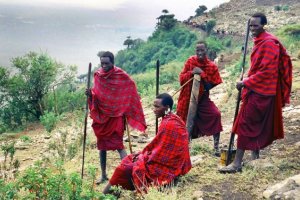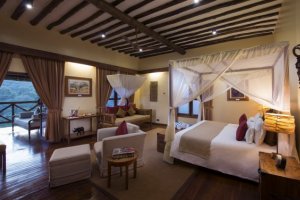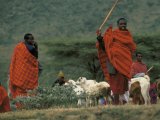Karibu means welcome in Swahili and there is no better place to enjoy an enriching cultural and wildlife experience than Tanzania. Tanzania’s spectacular landscape includes expansive rolling plains, massive mountains, great lakes and miles of white sand beaches. Combine this extraordinary beauty with the seemingly endless herds of wildebeest and zebra trekking across the plains on their annual migration – followed by lion, leopard, cheetah and hyena, Tanzania proves to be a suburb holiday destination. No matter if you choose a once in a lifetime safari, or conquering Africa’s highest mountain; Kilimanjaro ‘Roof of Africa’ or simply relaxing on the unspoiled beaches of Zanzibar, Tanzania offers something for everyone in the most idyllic climate conditions.

Tanzania & Zanzibar
General Information
General Facts:
Size: 885,800 sq km = 342,009 sq mi, including the islands of Mafia, Pemba, and Zanzibar
slightly larger than twice the size of California
Population: 46,912,768
border countries: Burundi, Democratic Republic of the Congo, Kenya, Malawi, Mozambique, Rwanda, Uganda, Zambia
Elevation Extremes: lowest point: Indian Ocean 0 m; highest point: Kilimanjaro 5,895 m (19,340 feet) , which is the highest point in Africa!
Religion: mainland - Christian 30%, Muslim 35%, indigenous beliefs 35%; Zanzibar - more than 99% Muslim. In Zanzibar - more than 99% Muslim
Languages: Kiswahili or Swahili (official), English (official, primary language of commerce, administration, and higher education), Arabic (widely spoken in Zanzibar), many local languages
Entry Requirements: Travelers to Tanzania require a valid Visa each time they enter the Republic.
The granting of a Tanzanian Visa is, in effect, only a form of pre-entry clearance. It does not guarantee permission to enter Tanzania. The Immigration Officer reserves the right to grant or deny admission. Visa holders are subject to normal Immigration control at the port of entry. They should therefore carry with them, for possible presentation to Immigration officers, the documents submitted with their applications.
In principle, all visitors, except those with no visa requirement as listed below, must obtain a visa prior to entry to Tanzania.
Visas can be obtained at any Diplomatic or Consulate Mission of the United Republic of Tanzania abroad, normally within one business day. Visitors are urged to do so to avoid any possible inconvenience at point of entry in Tanzania.
Cuisine/Beverages:
Tanzanian cuisine is both unique and widely varied. Along the coastal regions spicy foods are common, and there is also much use of coconut milk. Regions in Tanzania's mainland also have their own unique foods. A considerable proportion of the cuisine has been influenced by Indian cuisine. Some typical mainland Tanzanian foods include rice, maize porridge, chapati (a kind of bread), grilled meat, marinated beef, fish, plantains with meat. Commonly used vegetables include okra, spinach, green peas & beans. Snacks include breadrolls, kebab, rice bread, rice patties and many others. Many people drink tea (chai) in Tanzania, typically in the morning and coffee is usually taken in the evening. There are also local beverages/brews depending on the different tribes and regions.
What to wear:
For safaris in the north during the day, light clothing and hats. Sturdy shoes are recommended. At night, casual wear with a light cardigan or a pull over (for altitudes between 1500m in Arusha and 2400m in Ngorongoro). On the coast, summer wear. For Kilimanjaro or other treks, check with a mountain specialist before departure. To bring: sunscreen, lotions, sunglasses, mosquito cream and binoculars.
On safari, avoid brightly colored clothes. They may alarm the animals. Browns, beiges and khaki are preferred. Short-sleeved shirt/blouses and shorts are ideal, but pack a sweater. It can be chilly in the early morning and in the evening. Don't forget a swimsuit. Immodest clothing will offend local tradition.
Currency:
The basic unit is the Tanzanian shilling. It is advisable to carry American dollars. Moneys changers also accept the major convertible currencies. Travellers cheques are exchangeable in some places. Major credit cards are accepted in the larger hotels but it is advisable to carry cash.
Visitors can take in any amount of foreign currency and no currency declaration is required. But import and export of Tanzanian currency is illegal. Foreign currency in cash or travelers' checks may be exchanged at any branch of the commercial banks or through authorized dealers and at Bureaux de Change ("forex bureaux"), at the international airports, major towns, and border posts.
Electricity
230 volts AC, 50hz: round or square 3-pin plugs, fused or unfused.
Tipping
• Porters: A tip of US $1.00 per person is appropriate for two pieces of baggage at airports, hotels, lodges and camps. If you are travelling with more than two pieces of baggage, an additional tip of US$1.00 per bag is recommended.
• Driver-Guide: One driver-guide accompanies each land vehicle on safari. It is customary to tip your driver-guide on the last day you are with him or her. Approximately US $5 - US $7 per traveler per day is considered a good tip for a driver-guide (based on 4 – 6 travelers in a vehicle). If there are only 2 or 3 travelers in a vehicle, you may consider raising this amount to approximately US $6 - US $8 per traveler per day in recognition of the individual attention given to a smaller size group.
• Safari Escort: In addition to a driver-guide, some groups are accompanied by a professional safari escort. It is customary to tip your safari escort on the last day you are with him or her, and the recommended tip is US $8 to US $10 per traveler, per day. As with the tip for a driver guide, smaller groups (in this case, 5 or less) might consider tipping slightly more – in the range of approximately US $10 - US $12 per traveler per day.
• Mobile Camping: If you are travelling on a mobile camping safari (either independently or on a program) you will be served by a camp manager and several staff, for whom an overall tip of US $10 - US $14 per traveler per day in camp is recommended. This should be given to your guide on the last day for distribution among all camp staff. Again, smaller groups (in the case of 5 or less) might consider tipping in the slightly higher range of approximately US $12 - US $18 per traveler, per day (this applies to the exclusive camps, where tips are not included and not to the permanent tented camps).
Immunization and Health:
Travelers arriving from, or via, countries where yellow fever is endemic will need a Certificate of Vaccination although vaccination is available on arrival. Hospitals provide good medical care in cities and towns. Flying Doctors facilities are also
Available. For detailed information regarding the recommended vaccinations for your trip to Tanzania, please visit the web site of the CDC.
When to Travel?
Because Tanzania lies below the equator, the coolest months occur during the northern hemisphere’s summer, and all-year round the weather remains pleasant and comfortable. Between June and October, temperatures range from around 10°C in the northern highlands to about 23°C on the coast. On the plains and the lower-altitude game reserves, the temperatures from June to October are warm and mild. On the coast, these months are some of the most pleasant to visit, with balmy, sunny weather most of the day and cooling ocean breezes at night.
From December to March, the days are hot and sunny without often a cloud in the sky. Temperatures range from the mid-twenties to the low thirties throughout the country while visitors flock to the parks and beaches to escape the dreariness of late winter in colder climes. Clear sunny days are the norm in the northern highlands and the heat of mid-day is tempered by the golden light in the late afternoon and the especially striking sunsets. In the game parks and central plains, the beautiful weather provides perfect opportunities for unhampered game viewing, and clear night skies offer perfect opportunities for star-gazing and romantic evenings in the bush. On the shores of the Swahili Coast, the Indian Ocean reaches its highest temperatures and its ideal for swimming at any time of day or night.
Tanzania’s equatorial climate brings two seasons of rain each year: the masika or long rains that fall from mid-March to the end of May, and the mvuli or short rains, that come intermittently throughout November and parts of December, and sometimes stretch into early January. During the long rains, heavy showers fall in the early mornings but usually clear up by mid-day, with the weather often remaining clear and sunny until late afternoon. By evening, impressive cloud formations build, breaking sometime after dark and the rain often continues throughout the night. During the short rains, light showers in the mornings and late afternoons are punctuated by stretches of clear weather and beautiful rays of sunlight. The beginning of both rainy seasons is marked by a change in the winds which historically, marked the time for trading boats to set off on expeditions across the Indian Ocean or return to their native lands.
This information is courtesy of the Tanzania Tourist Board.
Travel Highlights
Serengeti
The name "Serengeti" has come to represent the safari experience itself, evoking images of sweeping savannahs swarming the lion, wildebeest, and gazelle. In the language of the Maasai the word means "endless pain" and the 5700sq. miles (14,763 sq. km) of park land in Northern Tanzania do indeed seem infinite. Upon these grasslands roam more game animals than anywhere in the world. There are over a million wildebeest alone.
Throughout the winter months of December to March (the best time to visit), many of the animals are concentrated in the park's southern regions, near Ngorongoro. During the spring months of May or June, the vast hears of Wildebeest and zebra start to head west in search of water, beginning acircuitous migration that takes some of them to shores of Lake Victoria, and others to northern areas and to Kenya's Maasai Marae park just across the border. Virtually every African game animal can be seen in the Serengeti.
Ngorongoro Selous Game Reserve
Ngorongoro is famous around the globe as an echo of Eden. It is a 12 mile (19 km) wide volcanic crater, ringed with towering walls and sheltering forests, grasslands, fresh sheltering forests, grasslands, fresh springs, a large lake, and a dazzling abundance of animals of all sorts. The sunken cone of the extinct volcano serves as a natural cradle for the wildlife, which remains in the vicinity year-round. The Selous is the largest game reserve in Africa. With about 21,000 sq. miles (55,000 sq. km), the reserve carves out a huge portion of Southern Tanzania. The immense size of the game reserve makes it ideal for the traveler seeking a sense of isolation, exploration, and discovery. Few (if any) other people will be visible.
Gombe Stream National Park Tarangire National Park
Gombe Stream lies at the northern end of Lake Tanganyika. The park's forested mountain slopes, which help define the Great Rift Valley are home to chimpanzees. Visitors can discover these fascinating creatures for themselves. The chimps are accustomed to humans and therefore somewhat approachable. Gombe Stream National Park is where Jane Goodall conducts her celebrated studies of chimpanzees.
Tarangire National Park is home to thousands of elephant in the dry season, when game congregates along the river, and is symbolized by the Baobab tree, growing in open acacia woodland. Tarangire is an ornithologists paradise rich in birds of prey and an incredible diversity of avifauna.
Mt Kilimanjaro
Mt Kilimanjaro is a vision that has fed the human imagination for years, Much more than the highest mountain in Africa, it is innately and inexhaustibly symbolic. Writers render it, climbers conquer it, Africans worship it, and at the end of the day its magnetic singularity remains undiminished. Though speechless wonder reigns in its presence, the traveler who witnesses Kilimanjaro Mountain will speak of it for years.
Rising 19,340 ft (5895 m) above the African plain, Kilimanjaro truly stands alone among the mountains of the world. The huge, solitary volcano is unaccompanied by any mountain chain. Though its size is immense, it also has one of the world's most accessible peaks. People who are in good shape can make the ascent to its summit, Uhuru peak, in a matter of days, passing through five distinctive ecological zones along the way.
The lower slopes of the mountain are defined by coffee and banana fields that rise up and end where the mountain's forest begins. An average of 80 inches of rainfall a year make the forest home to some botanical treats. At an altitude of about 9,000 feet, the forest gives way to grasslands and shrubbery, the elephant can sometimes be spotted roaming the high slopes. At about 13,000 feet life begins to recede, a result of extreme weather conditions inhospitable to anything more than small mosses and lichens. Once the summit area is reached, three glaciers and three volcanic peaks sit in lofty, placid contemplation of the tremendous plains over 3.5 miles below.
Lake Manyara
This fine park has a stature that far exceeds it modest 125 square mile (325 sq. km) area, having been a Mecca for seekers of wildlife, and for hunters, since safari travel began. Along its western border lie the cliffs of the Great Rift Valley escarpment, and its eastern border runs along the shores of Lake Manyara. Within this long and narrow corridor are dense concentrations of wildlife inhabiting a lovely and diverse landscape, which ranges from forest of tamarind, mahogany, and fig in the north to the wide open grasslands of the park centre. Elephant, giraffe, lion, buffalo, and zebra are all to be found here, in addition to many other game and bird species.
Zanzibar
The island of Zanzibar, the ornate and mysterious jewel of the Indian Ocean, was once the eastern gateway to Africa. It lies twenty-two miles off the Tanzanian coast, and it is no accident that the explorers Livingstone and Burton had homes here. Its lush forests and cloistered Arabic alleyways are indicative of all the esoteric wonders waiting in the continent beyond.
The island has long been a meeting a place of the world. Once the centre of the slave and ivory trade, Zanzibar welcomed into its harbour ships loaded with goods from India and the Far East as well as Europe and America. An Indian bazaar still operates on the island today, as well as the world's largest clove market. The Oman Arabs who once ruled the island left behind white-washed architectural delights that are in great condition. Among them are the Sultan's Palace, the Arab fort and the Beit el Ajaib (House of Wonders), which is Zanzibar's tallest building.
Visitors often remark that a journey to Zanzibar is like going back in time, the atmosphere is that of the age of colonialism and exploration, the haunting ruins of the slave market would be driven here from the interior of the continent, sometimes over 1,000 miles. On some days, hawkers would sell away as many as 600 lives.
Suggested Journeys
 Tanzania Classic Safari Experience
Tanzania Classic Safari Experience7 Days / 6 Nights • Daily arrival in Arusha, year-round
Embark on a week-long journey that will take you to some of Tanzania’s most enthralling destinations. Watch for lions, elephants and other creatures while exploring the Serengeti; relax along Lake Manyara and marvel at the unspoiled beauty found within the Ngorongoro Crater. This tour adds a touch of luxury to the classic safari experience.
A Safari through Tanzania with Private Driver via 4x4 vehicle, featuring Arusha, Lake Manyara, The Serngeti and the Ngorongoro Crater Conservation Area.
Featured Properties
 Exploreans Ngorongoro Lodge
Exploreans Ngorongoro LodgeSurrounded by 50 acres of unspoiled wilderness, this remarkable lodge puts you deep within the forests of Tanzania while enveloping you in pure comfort. It’s the ideal retreat for travelers who want to experience safaris and nature walks by day and then enjoy fine dining and opulent comfort at night.
 Singita Serengeti House
Singita Serengeti HouseExperience the wild and open Serengeti plains in refined comfort. The Singita Serengeti House is the ultimate in luxury adventure, providing a group of up to eight travelers with a rare chance to behold the raw beauty of Africa while enjoying warm, intuitive service by a team of dedicated staff.
 Singita Sabora Tented Camp
Singita Sabora Tented CampEmbark on an adventure that lives up to the romanticized vision of a classic African safari. The Singita Sabora Tented Camp meshes colonial-era elegance with a rare opportunity to experience the wilds of the Serengeti up close. All while enjoying the highest standards of luxury.
 White Sand Villas, Zanzibar
White Sand Villas, ZanzibarA sumptuous retreat surrounded by the sugar-white Paje beach, these villas provide an authentic island experience. But for those who crave a little more action, there’s a kitesurfing club located right at the resort.

